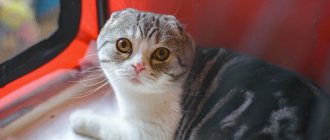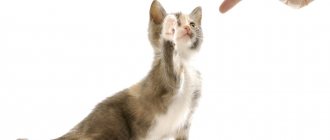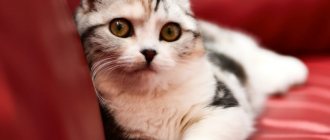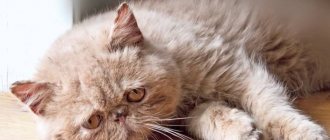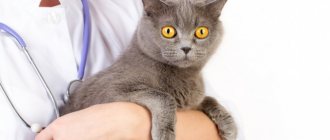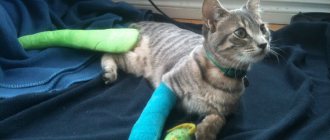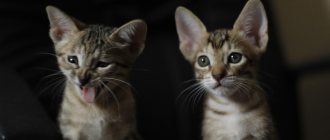What is blood type?
In mammals, antigen proteins are found on the surface of red blood cells (erythrocytes). Their task is to help the body recognize foreign objects entering the blood. If the body receives a signal about the penetration of a foreign antigen, antibodies begin to destroy it. Representatives of different blood groups have different antibodies on the surface of their red blood cells. It is on the basis of the type of antibodies that blood groups are distinguished.
Article continues after advertisement
Cats, as we have already said, have 3 blood groups: A, B and AB. The most common is group A (more than 90% of cats). V is less common. And AB is very rare (less than 1% of cats).
Different breeds have their own prevalence of blood groups. For example, Britons (in 60% of cases) and Cornish Rexes are carriers of type B antigens, and all Siamese cats, Birmans, Ocicats, and Orientals are A. Maine coons and Norwegian forest cats have group B in 5% of cases. In Abyssinian and Somali cats, as well as in the Kurilian Bobtail and Persians, the proportion of carriers of group B ranges from 5 to 25%. Scottish cats (Scottish Fold, Scottish Straight, Highland Fold and Highland Straight) are mainly group A, but in 10-20% of cases they have group B. Outdoor cats that do not have a breed are classified as group A.
Some researchers believe that cats have not 3, but 4 blood groups, but such data have not yet been confirmed. It is officially believed that blood type O, like in humans, is absent in cats: therefore, there are no universal donors among them.
There is also no Rh factor in cats.
INHERITANCE OF BLOOD TYPE BY A CHILD
Often in the maternity hospital, mothers are asked the question: “What cut group does my child have?” And then they think long and painfully: “Why did they say that my baby has the first blood type, if my husband and I have the second?”
To answer this question, let us remember what blood groups are and what laws of nature they “obey”.
At the beginning of the last century, scientists proved the existence of 4 blood groups.
The Austrian scientist Karl Landsteiner, mixing the blood serum of some people with red blood cells taken from the blood of others, discovered that with some combinations of red blood cells and serum, “gluing” occurs - red blood cells stick together and form clots, but with others - not.
While studying the structure of red blood cells, Landsteiner discovered special substances. He divided them into two categories, A and B, highlighting a third, where he included cells that did not contain them. Later, his students - A. von Decastello and A. Sturli - discovered red blood cells containing A- and B-type markers simultaneously.
As a result of research, a system of dividing blood groups emerged, which was called ABO. We still use this system today.
- I (0) – blood group is characterized by the absence of antigens A and B;
- II (A) – established in the presence of antigen A;
- III (AB) – B antigens;
- IV(AB) – antigens A and B.
The AB0 system has revolutionized scientists' understanding of the properties of blood. Genetic scientists began to study them further. They proved that the principles of inheritance of a child's blood type are the same as for other characteristics. These laws were formulated in the second half of the 19th century by Mendel, based on experiments with peas, familiar to all of us from school biology textbooks.
So how are blood groups inherited by a child according to Mendel’s law?
- According to Mendel's laws, parents with blood group I will give birth to children who lack A- and B-type antigens.
- Spouses with I and II have children with the corresponding blood groups. The same situation is typical for groups I and III.
- People with group IV can have children with any blood group, with the exception of I, regardless of what type of antigens are present in their partner.
- The inheritance of a blood group by a child is most unpredictable when the union of owners with groups II and III occurs. Their children are equally likely to have any of the four blood types.
- The exception to the rule is the so-called “Bombay phenomenon”. Some people have A and B antigens in their phenotype, but do not manifest themselves phenotypically. True, this is extremely rare and mainly among Indians, which is why it got its name.
TABLE OF INHERITANCE OF BLOOD TYPE BY A CHILD DEPENDING ON THE BLOOD GROUPS OF THE FATHER AND MOTHER
| MOM + DAD | CHILD'S BLOOD TYPE : POSSIBLE OPTIONS (%) | |||
| I+I | I (100%) | — | — | — |
| I+II | I (50%) | II (50%) | — | — |
| I+III | I (50%) | — | III (50%) | — |
| I+IV | — | II (50%) | III (50%) | — |
| II+II | I (25%) | II (75%) | — | — |
| II + III | I (25%) | II (25%) | III (25%) | IV (25%) |
| II + IV | — | II (50%) | III (25%) | IV (25%) |
| III+III | I (25%) | — | III (75%) | — |
| III + IV | — | I (25%) | III (50%) | IV (25%) |
| IV + IV | — | II (25%) | III (25%) | IV (50%) |
INHERITANCE OF RH FACTOR
The birth of a child with a negative Rh factor in a family of Rh-positive parents causes deep bewilderment at best, and mistrust at worst. Reproaches and doubts about the fidelity of the spouse. Oddly enough, there is nothing exceptional in this situation. There is a simple explanation for such a delicate problem, which is based on the same laws of genetics.
The Rh factor is a lipoprotein located on the membranes of red blood cells in 85% of people (they are considered Rh positive). If it is absent, they speak of Rh-negative blood. These indicators are denoted by the Latin letters Rh with a plus or minus sign, respectively.
The gene for a positive Rh factor is designated D, it is a dominant trait (always appears). The Rh negative gene is recessive and is designated d (appears only in the absence of D). Therefore, people with a set of DD or Dd chromosomes will have Rh positive blood, and only those with a dd chromosome set will have Rh negative blood.
Consequently, parents with a homozygous absence of the Rh factor (dd) can only give birth to children with Rh negative blood.
Parents with homozygous Rh positive factor (DD) will only give birth to children with Rh positive blood.
But in the union of people with Rh positive blood with heterozygous presence of Rh (Dd), their children will have Rh positive in 75% of cases and negative in the remaining 25%.
So, parents: Dd x Dd. Children: DD, Dd, dd – these are Rh negative children of Rh positive parents! .
Inheritance of the blood type of the Rh system, possible in a child, depending on the blood groups of his parents.
| Mother's blood type | Father's blood type | |
| Rh(+) | rh(-) | |
| Child's blood type | ||
| Rh(+) | Any | Any |
| rh(-) | Any | Rh negative |
And some more interesting things from geneticists...
INHERITANCE OF CHARACTERISTICS
For centuries, parents have only wondered what their child would be like. Today is an opportunity to look into the future. Thanks to ultrasound, you can find out the gender and some features of the anatomy and physiology of the baby.
Genetics will make it possible to determine the likely color of the eyes and hair, and even whether the baby has an ear for music. All these characteristics are inherited according to Mendelian laws and are divided into dominant and recessive.
Brown eye color, hair with small curls, and the ability to roll the tongue into a tube are dominant signs. Most likely, the child will inherit them. Unfortunately, dominant signs also include a tendency to early baldness and graying, myopia and gaps between the front teeth.
Gray and blue eyes, straight hair, fair skin, and a mediocre ear for music are considered recessive. These signs are less likely to occur.
BOY OR...
For many centuries, the blame for the lack of an heir in the family was placed on the woman. To achieve the goal of having a boy, women resorted to diets and calculated favorable days for conception. But let's look at the problem from a scientific point of view. Human sex cells (eggs and sperm) have half the set of chromosomes (that is, there are 23 of them). 22 of them are the same for men and women. Only the last pair is different. In women these are XX chromosomes, and in men they are XY.
So the probability of having a child of one sex or another depends entirely on the chromosome set of the sperm that managed to fertilize the egg. To put it simply, the father is entirely responsible for the gender of the child!
Head of the department for newborn children Ilkevich N.G.
Neonatologist of the department for newborn children Valentyukevich T.S.
Why do you need to know your cat's blood type?
Any animal may need a blood transfusion if a pathology or injury requiring it occurs. But if blood is transfused from a donor with an unsuitable group, foreign proteins will be destroyed by the recipient’s body, which will lead to complications and even death.
Can a person become a blood donor for a cat? No. Human blood is different from cat blood. Only another cat can become a donor for a cat: an adult (over 1 year old), large (weighing over 4 kg), healthy, vaccinated, with a calm character (to make the procedure easier).
There are no blood banks for cats. Therefore, volunteers (with the permission of the owners) or animals specially kept for this purpose in veterinary clinics are used as donors. They can share their blood no more than once a month.
But finding a donor is not always easy, especially for cats with a rare blood type. Therefore, for owners who have several cats, knowledge of blood groups will allow them not to look for a donor on the outside, but to immediately bring two animals to the veterinarian.
Article continues after advertisement
You also need to know your blood type for proper crossing and obtaining healthy offspring. This trait is inherited and therefore important. Next we will explain why. And now you can familiarize yourself with the table illustrating the patterns of inheritance of blood groups.
Data on the blood type, if known, are indicated in the animal’s veterinary passport.
What to do in case of possible danger?
Of course, for breeds, it is advisable to know the blood types of your pets in advance and cross only animals with the same groups. American breeders advise that when breeding those breeds in which the occurrence of group B does not exceed 5% (Maine Coons, Norwegian Forest), to identify such animals and exclude them from the breeding process. If blood group B is more common in the breed being bred and this pair is crossed for the first time, in order to avoid troubles, it is worth determining the blood types of the kittens immediately after birth.
There is a special test for this, although it is quite expensive. For the test, one or two drops of a kitten's blood from its umbilical cord is enough. The blood typing test for adult cats is cheaper and more common. To do this, you need to take 1-2 milliliters of blood from the cat's paw. Kittens with identified blood type A should be immediately separated from their mother, who has type B, and find a temporary nurse for them - a cat with blood type A (a mongrel domestic cat is perfect) or feed the kitten with a cat's milk replacer. 2-3 days after birth, the kitten can feed on the milk of its mother. By this time, the permeability of the baby’s intestinal wall decreases so much that antibodies from mother’s milk cannot penetrate into the blood and the kitten’s life is not in danger.
If it is not possible to determine the blood type of newborns, the following options exist. Firstly, you can separate all kittens from their mother for 2-3 days after the first feeding and act in accordance with the above. Secondly, you can do a urine color test. To do this, after the first feeding (quite short), the kittens should massage their tummies, thereby stimulating the secretion of urine. The urine should be blotted with a cotton swab. Normally, urine should be almost colorless. If the urine is brownish, it means the kitten and its mother have incompatible blood types. The urine is colored due to the entry of destroyed red blood cells. Such kittens should be separated from their mother.



